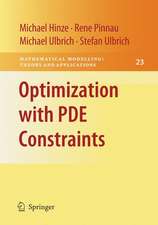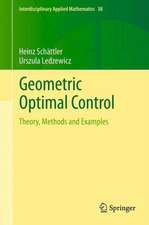Linking Methods in Critical Point Theory
Autor Martin Schechteren Limba Engleză Hardback – iul 1999
| Toate formatele și edițiile | Preț | Express |
|---|---|---|
| Paperback (1) | 641.38 lei 43-57 zile | |
| Birkhäuser Boston – 6 oct 2012 | 641.38 lei 43-57 zile | |
| Hardback (1) | 647.40 lei 43-57 zile | |
| Birkhäuser Boston – iul 1999 | 647.40 lei 43-57 zile |
Preț: 647.40 lei
Preț vechi: 761.65 lei
-15% Nou
Puncte Express: 971
Preț estimativ în valută:
123.88€ • 129.69$ • 102.50£
123.88€ • 129.69$ • 102.50£
Carte tipărită la comandă
Livrare economică 07-21 aprilie
Preluare comenzi: 021 569.72.76
Specificații
ISBN-13: 9780817640958
ISBN-10: 0817640959
Pagini: 294
Ilustrații: XVII, 294 p.
Dimensiuni: 155 x 235 x 20 mm
Greutate: 0.61 kg
Ediția:1999
Editura: Birkhäuser Boston
Colecția Birkhäuser
Locul publicării:Boston, MA, United States
ISBN-10: 0817640959
Pagini: 294
Ilustrații: XVII, 294 p.
Dimensiuni: 155 x 235 x 20 mm
Greutate: 0.61 kg
Ediția:1999
Editura: Birkhäuser Boston
Colecția Birkhäuser
Locul publicării:Boston, MA, United States
Public țintă
ResearchCuprins
1 Critical Point Theory.- 1.1 Introduction.- 1.2 Other Geometries.- 1.3 Semilinear Boundary Value Problems.- 1.4 The Critical Point Alternative.- 1.5 The Mountain Cliff Theorem.- 1.6 Estimates on Eigenspaces.- 1.7 Asymptotic Limits.- 1.8 Types of Resonance.- 1.9 Multiple Solutions.- 1.10 Eigenvalues.- 2 Linking.- 2.1 The Basic Concept.- 2.2 The Flow.- 2.3 Weaker Conditions.- 2.4 Another Form.- 2.5 Some Consequences.- 2.6 Examples of Linking.- 2.7 Critical Sequences.- 2.8 The Compact Case.- 2.9 A Sandwich Theorem.- 2.10 Appendix I: Pseudo-Gradients.- 2.11 Appendix II: Differential Equations.- 3 Semilinear Boundary Value Problems.- 3.1 Introduction.- 3.2 Mountain Pass Geometry.- 3.3 Finding a Critical Sequence.- 3.4 Obtaining a Solution.- 3.5 Solving the Problem.- 3.6 Resonance.- 3.7 Appendix I: The Sobolev Inequality.- 4 Alternative Methods 73.- 4.1 Introduction.- 4.2 The Saddle Point Alternative.- 4.3 An Alternate Form.- 4.4 Some Corollaries.- 4.5 An Application.- 4.6 Superlinear Problems.- 4.7 Some Modifications.- 5 Bounded Saddle Point Methods.- 5.1 Introduction.- 5.2 A Bounded Mountain Pass Lemma.- 5.3 The Mountain Pass Alternative.- 5.4 A Compactness Condition.- 5.5 Dual Situations.- 5.6 Combined Results.- 5.7 Nonlinear Eigenvalues.- 5.8 Double Resonance.- 5.9 Appendix I: Generalized Pseudo-Gradients.- 6 Estimates on Subspaces.- 6.1 Introduction.- 6.2 Some Important Quantities.- 6.3 The Estimates.- 6.4 Nontrivial Solutions.- 6.5 A Variation.- 7 The Fu?ík Spectrum.- 7.1 Introduction.- 7.2 Jumping Nonlinearities.- 7.3 Quantities Related to the Fu?í k Spectrum.- 7.4 Applications.- 8 Resonance.- 8.1 Introduction.- 8.2 More on Double Resonance.- 8.3 Resonance Involving Many Eigenvalues.- 8.4 Landesman—Lazer Resonance.- 8.5 Equal Limits at Infinity.- 8.6Nonvanishing Solutions.- 8.7 Unequal Limits at Infinity.- 9 Boundary Conditions.- 9.1 Introduction.- 9.2 Bounded Linking.- 9.3 Reverse Boundary Conditions.- 9.4 An Application.- 9.5 Sufficient Conditions.- 10 Multiple Solutions.- 10.1 Introduction.- 10.2 The Abstract Theory.- 10.3 Some Applications.- 10.4 Additional Solutions.- 11 Nonlinear Eigenvalues.- 11.1 Introduction.- 11.2 The Hampwile Theorem.- 11.3 Applications.- 12 Strong Resonance.- 12.1 Introduction.- 12.2 Simple Solutions.- 12.3 A Different Approach.- 12.4 Resonance at the First Eigenvalue.- 12.5 Additional Solutions.- 13 Notes, Remarks and References.
Recenzii
"The main merit of this work is the utmost clearness through which the author explains some subjects connected with very strong technical difficulties... The particular way used...to introduce the basic aspects of linking methods will be very encouraging and stimulating for young researchers... The book may be warmly recommended to all specialists in this fascinating field of current interest and growing importance."
--ZAA
"The book is addressed to mathematicians and students interested in critical points in any context...recommended also for researchers in the fields of pdes and nonlinear analysis... This reviewer calls the attention of the designers of algorithms for determining critical points to this book as a possible theoretical basis for new powerful numerical methods."
--Acta Sci. Math
--ZAA
"The book is addressed to mathematicians and students interested in critical points in any context...recommended also for researchers in the fields of pdes and nonlinear analysis... This reviewer calls the attention of the designers of algorithms for determining critical points to this book as a possible theoretical basis for new powerful numerical methods."
--Acta Sci. Math



















